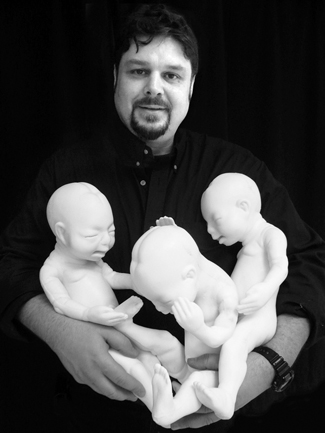Francis LeBouthillier | Medical Sculptor

“Everybody is born,” says Rory Windrim, a specialist in high-risk obstetrics at Mount Sinai Hospital in Toronto.
Not everybody has an easy time of it though. While the vast majority of pregnancies go smoothly, the small percentage that do not become a powerful focal point for both expecting parents and doctors like Windrim.
Consider a rare fetal condition known as “congenital diaphragmatic hernia” or CDH.
The diaphragm is a layer of muscle that separates the chest cavity from the abdominal cavity. A fetus with CDH lacks some or all of this barrier. Without the diaphragm, the intestine, spleen, stomach and liver can press up on the lungs, preventing them from developing properly.
A fetus doesn’t need lungs, but a baby does. That means a mother can carry a CDH pregnancy to term, and then lose the child immediately at birth. Here’s what doctors can do about it: Using laparoscopy, they can work a tiny balloon through the womb, into the mouth of the fetus, down the throat and lodge it at the top of the lungs. With this barrier in place, the fetus’s lungs fill with fluid creating enough pressure to push back the abdominal organs. The lungs have room to grow.
But the danger isn’t over. Doctors must remove this balloon just before the baby is born, so that her airways are clear when she takes her first breath.
How do you test something like this? How do you refine the procedure? How do you train surgeons in something so elaborate, and with such grave consequences? How can new surgical teams practice until they get it right? Even less complicated in-utero treatments such as amniocentesis and fetal blood transfusions once had to be learned on the job. “Practitioners of this kind of procedure went through a training program where a more experienced teacher mentored them with real babies and real pregnancies,” Windrim says. “The lay public might expect that the person starting the procedure had done it before. That wasn’t always the case.” This form of training demanded great surgeons who also happened to be great teachers.
“It took a very experienced teacher where your hands become his or her hands,” says Windrim. “I was lucky enough to have one of those teachers.” He is now a teacher himself, and is keenly aware of how stressful it is for many trainees to master such delicate, high-stakes procedures. His career, though, happens to have coincided with an expanded role for simulations. Not computer simulations – no graphics could duplicate the feel of a needle puncturing a uterus, or the physical reaction to lodging a balloon in a fetus’ throat. To test and practice this kind of procedure, they needed physical simulations. That’s where OCAD University sculptor and researcher Francis LeBouthillier came in. “We contacted Francis to see if he could make models for some of these procedures,” Windrim said. “The first was an amniocentesis. Francis built a simulated womb and fetus that allowed trainees to practice the procedure without posing any risk to an actual mother or child.”
LeBouthillier not only had to research the medical procedure, but also had to find the right materials for his models. The material had to be ultrasound compatible. It had to be durable. A needle couldn’t leave an “optical scar” – which would cause the model to lose ultrasound transparency over time. The partnership between sculptor and surgeon developed over many years, with new models allowing the practice of increasingly complex procedures, including CDH. “This procedure is usually done between 24 and 28 weeks – we got MRIs of bronchi and lungs of babies at that age and asked Francis to create a simulation with accurate throat and windpipe,” Windrim says. LeBouthillier’s models not only allowed a medical team to learn how to do the procedure, it also helped them decide whether they should.
“The model has allowed us to step forward into a new area as carefully as possible. Every possible due diligence has been paid to making it as safe as possible for mothers for this still- under-investigation technique,” he says. While it’s difficult to gather clinical data on the effect of simulation training on mother-and-child well-being, Windrim has no doubt that LeBouthillier has made a huge difference to the field. He is part of a team led by Mount Sinai’s Greg Ryan that has treated several challenging CDH cases, and attributes their success to their collaboration with LeBouthillier.
“It’s hard to see how else we could have prepared for that first case,” he says. “We worked it out step by step as a team with our paediatric colleagues at Mount Sinai and the Hospital for Sick Children. I can’t see how we could have proceeded as safely without Francis’ model.”
By Patchen Barss
Source